Oysters are a name for a number of different marine and freshwater mollusks. They are bivalves, which means oysters body are compressed and are enclosed within a hinged shell. Other examples of bivalves are clams, scallops and mussels. There are different varieties of these slimy and raw mollusks. In here, let us talk and learn more about oysters and the different types of oysters there are. Check out the guide below to know more.
Different Types Of Oysters
The different types of oysters have different taste and shape that greatly depends on where it was harvested. Most of the time, the location can impact the taste and shape of the seafood quality. Aside from environmental factors, the water salinity can also affect the taste and shape of where each oysters grow.
Listed below are different types of oysters that are popular and commonly consumed along with each of their unique characteristics.
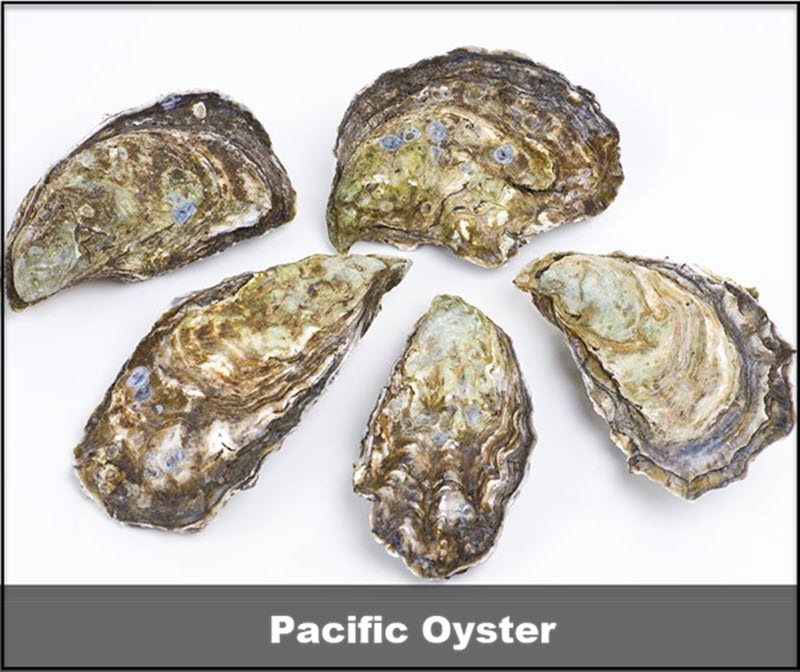
Pacific Oysters (Crassostrea Gigas)
Pacific Oysters are also known for as Japanese Oyster, Creuse or Miyagi Oyster. Pacific Oysters known to be the most cultivated oyster in the US Pacific Coast and in the world. Although pacific oysters are not its native, they were initially brought to the United States and other countries for the other purpose (Aquaculture) which then later became the most cultivated type and has been popularly growing in the West Coast and Europe as well as in North America, Australia, and New Zealand.
Most of Pacific oysters have shells that features ruffled edges. Its shells are distinct from other types because it is more lengthy. Pacific Oyster shell colors are commonly seen as colored green and gray, but sometimes there are also shells with different colors such as gold, royal purple and jade green.
Crassostrea Gigas tend to grow fast with an average growth of about 10-15 cm in just 24 to 48 months.
Pacific oysters generally have a sweeter and tastes a little briny than the rest of the types of Atlantic Oyster species. Other flavors of Pacific oysters is a mixture of melon, vegetal, creamy and brackish.
Examples of Pacific oysters are Penn Cove, Fanny bay and Kusshi.

Kumamoto Oyster (Crassostrea Sikamea)
Kumamoto oyster is also known is another names such as Kumi “Kumies” or Kumo. A native of Japan, Kumamoto Oysters has gained its popularity in the West Coast of Northern America and Pacific Northwest as well. It was first considered to be a sub-species of Pacific oysters.
Kumamoto Oysters is slow growing oysters that usually take about 36 months (3 years) to grow, however despite its minute size it can still offer that deliciously sweet but fruit flavor.
Kumamoto Oysters are quite alike with other varieties in terms of its shape that is also irregular and the valves are unequal as well. However, they are quite small as compared to other varieties. Kumamoto oysters grow to a maximum of just about 60mm. Kumamoto Oysters can be identify with the design and color of its shell with its green and black tone along with pointy edges.
Kumamoto Oysters strive well on relatively warm waters than cold waters, perhaps because they are quite accustomed to the warm waters in Japan.
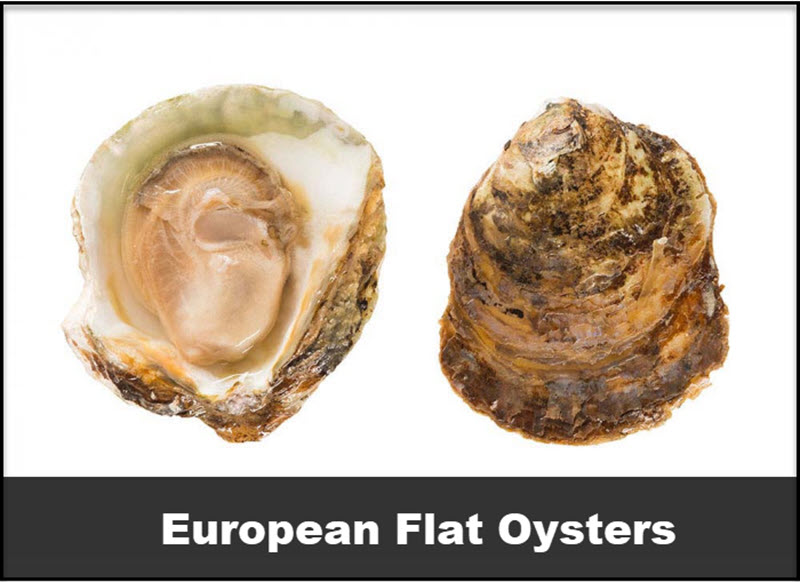
European Flat Oysters (Ostrea Edulis)
European flat oysters are also known for in other names such as Belon Oysters, that exclusively grows in France. However, European flat oysters can only be called Belon oysters if they grow in France but not all Belons are European Flats, while not all European Flats are Belons.
European flats oysters shells are flat, smooth and round. It also features a shallow up and its color is more like a seaweed tone. When cooked, the color changes to ivory. Also, because of its saucer-like cup, they are sometimes referred to as plates oysters.
These type of oysters are less briny with creamy taste that somehow also compliments a metallic taste , its meat are light brown.

Olympia Oysters (Ostrea Lurida)
Olympia Oysters are also referred to as Oly. Originally from the Northern Pacific Coast of North America, but later on has become popular and later inhabits the West coast of Canada.
Olympia Oysters are also known for in other names such as Native Oyster, Rock Oyster, and California Oyster. A widely popular cocktail oysters across the globe.
Although Ostrea Lurida and European Flats comes from the same family of species, Olympia oysters are considered to be the smallest specie as compared to European flats. Relatively small, the size of a coin. Olympia oysters hues range from purple to brown and yellow.
When cooked, Olympia oysters have a mild sweetness with a coppery taste in between.

Sydney Rock Oysters (Saccostrea Glomerata)
Sydney Rock Oysters are also known as Auckland oysters and New Zealand oysters, that from the name itself are a native to both New Zealand and Australia. Other names includes Rock Oyster and Western Rock Oyster.
Typically, Sydney Rock oysters can live up to 10 years. They are small, however, they can grow to up to 6-8 cm length. Over 3 years, they can reach up to 60kg of weight.
Sydney Rock Oysters have thick but smooth shells. On its inner rim of its upper shell are tiny hinge”teeth”. Its color hue are gray colored, while on its inside are smooth and white colored.
Sydney Rock Oysters have a rich and creamy taste, though with a touch flavor of Iodine.
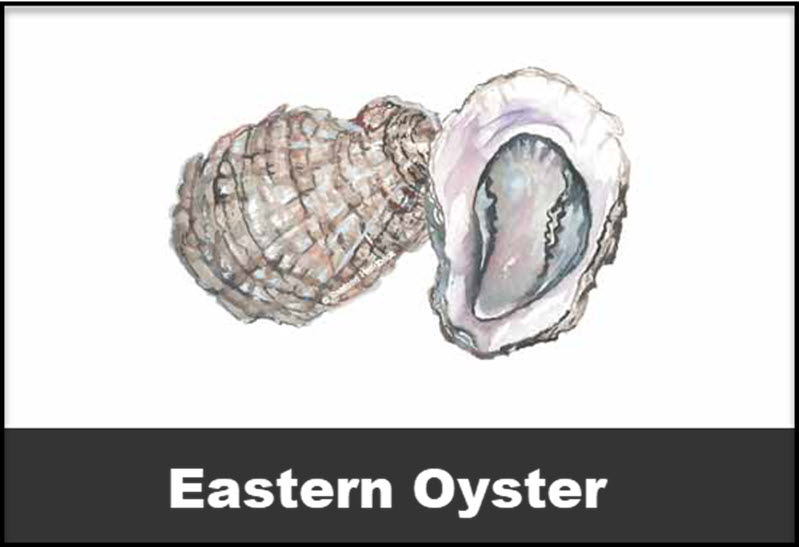
Eastern Oyster (Crassostrea Virginica )
Eastern oysters are also called Atlantic Oysters, typically found on the North American Atlantic Coast. In the US alone, almost 85% of Atlantic Oysters are harvested that is why it is also known for as “The American Oyster” and the rest comes from Mexico.
Other names for Atlantic Oysters that are known for are Wellfleet oysters and Virginia Oyster.
One distinguishing feature of Atlantic Oysters are its hard calcium-carbonaceous shells. The hard shells typically protects Atlantic Oysters from predators. Although Atlantic Oysters are quite large, grows to a maximum of 10 cm in length and are pear-shaped. The exterior shell of Atlantic Oysters has a gray colored hue with a white hue on its interior and muscle scar with a deep purple hue.
Atlantic Oysters or Eastern Oyster has a Briny taste and the its meat are quite chewy.
Other Oyster Varieties:
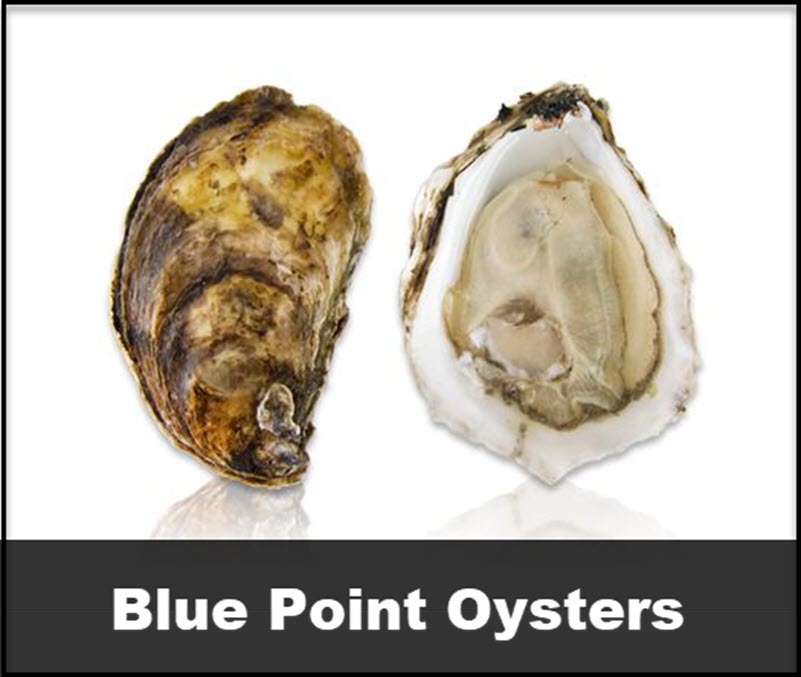
Blue Point Oysters
Blue Point Oysters are named after the Blue point town located in Long Island as East coast oysters. Most oysters harvested in several locations such as in New York and Connecticut.
Blue Point Oyster is widely popular back in the 1800s, and because of its wild and strong flavor it eventually became the favorite oyster of the Queen Victoria.
It has a mild, meaty but briny flavor. Although most of the time Blue Point Oyster is served and eaten raw.
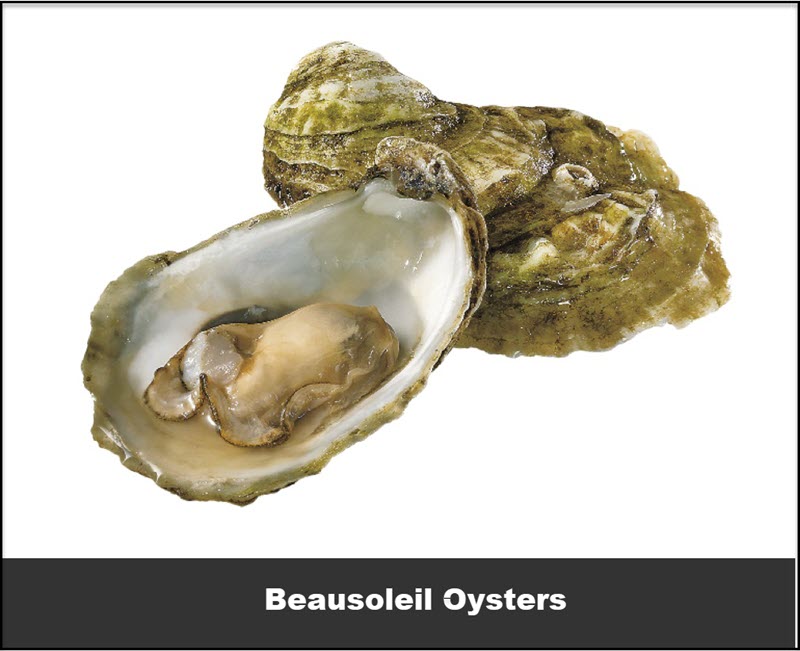
Beausoleil Oysters
Beausoleil Oysters is another Atlantic oyster that comes from New Brunswick in Canada. The term Beausoleil which means Beautiful Sun. Beausoleil Oysters typically grows to about 2 1/2 inches.
An interesting feature about this type of oysters is that they are farmed using the tray suspension method. The Suspended culture method allows oysters to grow in deep tidal waters. The process involves placing the oysters in a tray or some use nets that are then suspended from floats allowing the oysters to hang for about 24 hours just below the surface of water so that these oysters can grow up very fast.
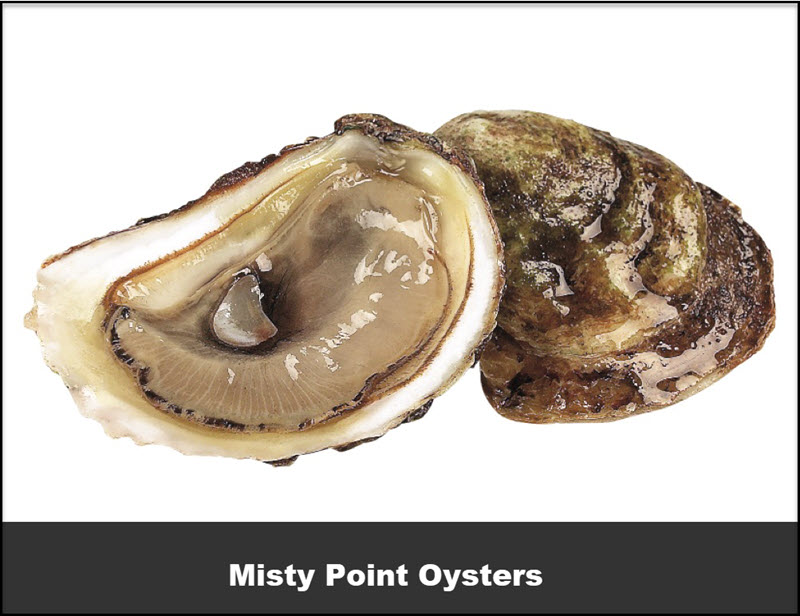
Misty Point Oysters
Misty Point Oysters are raised on the Eastern shore of Popes Bay, Virginia. They typically grow to an average size of about 3 inches and are usually harvested using the rack and bag cultivation process.
The rack and bag cultivation method involves placing a steel rack on the sand, the bags that can either be plastic or mesh are filled with those small oysters are settled down on top of the steel racks which are then surrounded by water whenever the tides comes. Basically, this method helps the shells of the oysters to harden, while allowing it to shape in prominent cups.
Minty Point Oysters have a salinity taste but sweet taste and are chewy too with finishes hint of lettuce and celery.
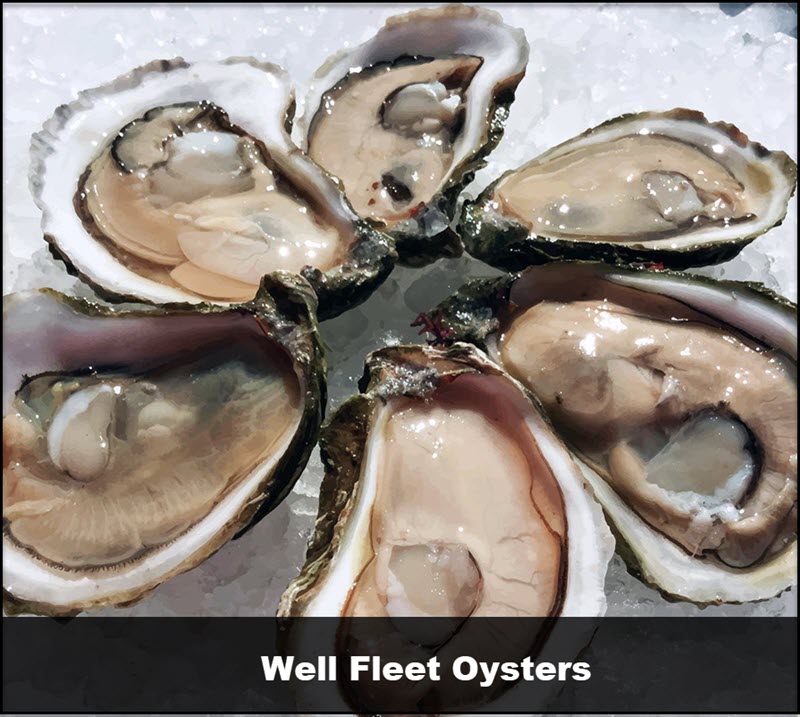
Well Fleet Oysters
Well Fleet Oysters are widely known and most popular New England Oysters. They are farmed in the intertidal flat along Wellfleet harbor, hence the name Well Fleet.
These types of oysters strives best in cold water that helps Well Fleet oysters preserve their meaty but sweet flavor. They do this by relatively building up its glycogen that somehow slows downs its metabolism process, thereby distinct flavors are preserved. These types of oysters can grow to an an average height of 3 and a half inches.
The creamiest sweetness flavor that Well Fleet oysters offers is what make these oysters tastes so good.
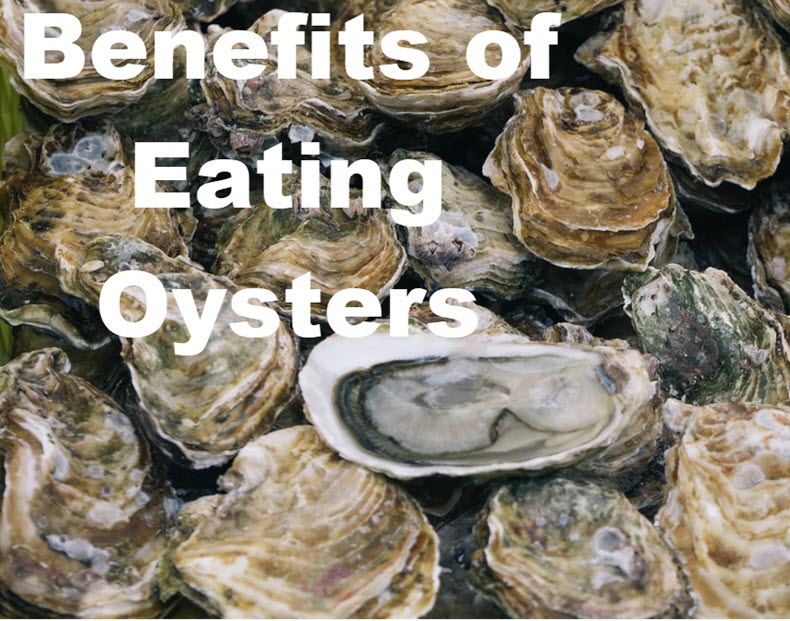
Benefits of Eating Oysters
For some consuming raw and even cooked oysters can be unpleasant, there are however several benefits that you can get from eating Oysters such as:
- Helps in the healing process: Oysters help increase your immune system thereby helps in the healing process and helps fight against bacteria.
- Rich source of protein: Oysters are high in protein that helps repair tissues and promote growth of muscles.
- High in Calcium: Oysters promotes healthy bones and teeth while at the same time increases bone strength.
- Improved Blood circulation: Helps in developing and increasing Red blood cells in the body as a result of preventing iron deficiencies and anemia.
- Promotes Heart health: Oysters helps reduce bad cholesterol in the blood protecting the health of your heart.
How to clean and store Oysters
To be able to served fresh oysters, you have to keep them alive before they are due for cooking. Therefore it is recommended to properly and carefully handle oysters as soon as they arrive from where it was harvested. Follow the tips below on how to properly clean and store oysters to keep them the freshest oysters as possible.
Cleaning Oysters:
Most of the time, Oysters are gathered and harvested from underwater that typically tends to be muddy. As a result, the shells will most likely be muddy as well. To clean oysters, follow the simple steps below:
- Put Oysters in a strainer under a running water. Alternatively, you can place ice on top of the oysters on the strainer. The melting ice will keep them cold and fresh while at the same time will wipe the dirt from the shells.
- Using a brush, you can scrub off the remaining mud from the shells. After cleaning the Oysters, it is now ready to be served. Tip: Never soaked Oysters in freshwater, it can hasten its deterioration and could eventually spoil its smell.

Storing Oysters:
If at some point, when the Oysters arrived and you are not sure when it will be served. You need to know the proper way of storing these oysters until it is ready to be served to keep it fresh. Follow the steps below:
- In the refrigerator, place a damp towel on the baking sheet.
- Gently place the Oysters on the layers on the towel. Make sure the cup side is facing down. Then put another damp towel on top of the first layer. This method helps increase Oyster shelf life.
- Alternatively, to keep it fresh you can place the Oysters inside a cooler full of ice from where they were shipped.
How to eat Oysters
For first timers, looking into Oysters bivalve can be confusing. Although sometimes tricky, opening and serving Oysters can be a whole new experience.

How to Open Oysters
Opening Oysters for the very first time can be difficult, but all you need are shucking knife and gloves.
- Place Oyster 1/2 on the clean towel, then fold the other half shell wherein it could completely cover the oyster, make sure the hinge are revealed.
- Inset the tip of the Shucking knife to the revealed hinge of the Oyster.
- Using a gentle pressure, gently move your way into the shell using the knife while at the same time moving the shucking knife towards oneself (Shucking Knife should be on top of the shell). This time, unhinged the shell of the oyster using the shucking Oyster knife.
- The top of the shell is now unhinged, you can now gently remove the meat that is “attached” to the interior of the shell.
- To keep it fresh, place the removed oyster on ice and then serve.

How to Serve Oysters:
There are different ways and different presentations on how to serve oysters. Other serve it raw, while some pairs it with their favorite drinks. There are also different cooking preparations used when serving Oysters. Below are different servings suggestions:
- Most of the time, Oysters are served raw. To keep it fresh, they are placed in a bed of ice. It is sometimes served together with a dipping sauce (acid flavor) that helps reduce its briny flavor.
- Oysters are sometimes paired with Lemon and in combination with red wine and black pepper.
- When serving raw oysters, it is often paired with several ingredients such as Pomegranates, cucumber, watermelon and Passion fruit. This combination also helps with reducing the briny flavor of the oyster.
- Several cooking suggestions include but not limited to Baking, broiling, frying, smoking and stewing.
- Oysters are also best paired with other food such as: mushroom, fruits, cheese, caviar. All can help with the oyster salinity taste.
- A good recommendation that compliments will with Oysters brininess is by pairing it with Champagne.

